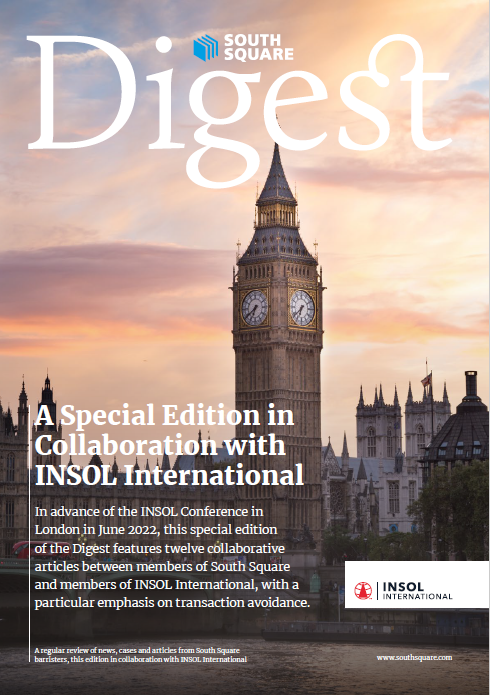

Introduction: Ancient and Roman Law
Modern avoidance provisions as they are known today were almost non-existent in ancient legal systems. This is unsurprising given that the consequences of insolvency were directed largely towards the insolvent’s person as opposed to their property. Ancient Hindu, Babylonian and Roman law typically allowed for insolvent debtors to be sold into slavery while religious sanctions such as excommunication were also used as deterrents to prevent fraud, of which insolvency was considered a species. The gradual evolution from retaliatory to compensatory objectives of legal systems eventually saw the development of what can be recognised today as proto-avoidance provisions. To that end, Roman law developed elaborate provisions for vitiating fraudulent transfers. For present purposes, three broad types of fraudulent transfers may be identified: (i) acts of forbearance by which a debtor diminished the amount of property available to creditors; (ii) transfers without consideration even if the transferee was wholly innocent; and (iii) transfers for valuable consideration where the transferee had notice of the fraud.
Creditors had available a range of remedies both in personam and in rem in response to such fraudulent alienation including: (i) an actio Pauliana in personam; (2) an interdictum fraudatorium; (3) an actio in factum available against a bona fide alienee; and (4) the integrum restitutio with a view to an action in rem. The description of the ‘actio Pauliana’ or ‘Paulian action’ in the Institutes of Justinian will be familiar to modern insolvency lawyers:
‘… if any one has transferred his property to another in fraud of his creditors, upon judgment to that effect by the chief provincial magistrate, the creditors of the transferor may seize his property, avoid the transfer and recover the things transferred; that is, they may claim that the things have not been transferred at all and accordingly are still within the legal possession of the debtor.’
The ‘actio Pauliana accordingly permitted a creditor who had taken possession of a debtor’s property pursuant to a judgment to bring ‘an action against the holder of the alienated property, since the alienation is in fraud of them’ and also extended to the recovery of profits.
The Middle Ages and the Law Merchant
Despite a revival of trade and commerce and the introduction of the lex mercatoria or Law Merchant in England in the late thirteenth century, it was not until the late fourteenth century that some early legislative attempts were made to avoid fraudulent transactions.
Beginning in 1376, three legislative attempts were made to control flight to sanctuary and the then prevalent practice of fraudulent conveyances to frustrate the efforts of execution creditors to obtain payment of their debts. The statutes, 50 Edward III c.6 (1376)3 2 Richard II c.3 (1379) and 3 Henry VII c.4 (1487),4 only applied to fraudulent conveyances where the debtor had entered a legally defined safe haven5
The 1376 statute provided, relevantly:
‘… if it be found that [the giving by creditors of their tenements or chattels to ‘friends’] be so made by collusions, that the said creditors shall have execution of the said tenements and chattels, as if no such gift had been made.’
Each of these three statutes provided relief against fraudulent alienations of property for the use of the debtor himself, but did not provide relief in respect of alienation of property for the benefit of others such as ‘favoured creditors’. By the first half of the sixteenth century, the role and influence of the Staple Courts hearing commercial disputes was in decline, and creditors were once again left largely to the inadequate machinery of the common law requiring individual creditors to pursue individual remedies. In the absence of specific legislation, fraudulent alienations of property by insolvent debtors continued6.
Early English bankruptcy and avoidance provisions under the Tudors
While some debate exists, it is generally considered that the first English Bankruptcy statute was the Act introduced during the reign of King Henry VIII entitled ‘An Act against Such Persons as Do Make Bankrupt’ 34 and 35 Henry VIII, c .4 (1542),7
(‘the 1542 Act’). Some historians argue that the 1542 Act ‘can hardly be spoken of as a true bankruptcy law, for it is in fact little more than a criminal statute directed against men who indulged in very prodigal expenditures and then made off’.8 Those historians argue that the foundations of modern bankruptcy laws were not fully laid until the passage of the bankruptcy statutes during the reign of Queen Anne, 4 Anne c.17 (1705) and 10 Anne c.15 (1711), which showed ‘the first signs of any relenting from the severity of its predecessors towards the unfortunate insolvent’ and contained all of the elements of modern bankruptcy including discharge.9 If and however that debate may be resolved, the 1542 Act, despite its penal character, was the first attempt in English law to deal with fraudulent debtors by a ‘compulsory administration and distribution, on the basis of a statutable equity or equality among all the creditors’.10
The 1542 Act introduced summary collective execution and pro rata distribution of a fraudulent debtor’s property11 and specifically dealt with fraud on creditors, by providing for the recovery of debts if the ’offenders’, as bankrupts were called:
‘… intend to delay or defraud their Creditors deceitfully by covin or collusion, suffer … any other person to recover … debts … without … just cause and title so to do, proceeding bona fide, without fraud’.12
Debtors could face imprisonment, and anyone who assisted a debtor to defraud creditors was also liable to punishment. The 1542 Act did not, however, provide adequate definition of, or procedures for, the collection and realisation of the bankrupt’s property, and, accordingly, is commonly thought to have been unsuccessful.13
The deficiencies of the 1542 Act were addressed during the reign of Queen Elizabeth I, with the passage of two statutes in 1571. The first, entitled ‘An Act Touching Orders for Bankrupts’14 introduced two significant elements to the bankruptcy system: the statute was expressly limited to merchants15 and it created the office of Commissioners of bankruptcy who were to be appointed by the Lord Chancellor to collect and sell the bankrupt’s property for rateable division among the unsecured creditors16 and, if necessary, commit the bankrupt to prison. The second, known as the ‘Fraudulent Conveyances Act’ or simply the Statute of Elizabeth I, is generally acknowledged as ‘the foundation of the modern law’ concerning transaction avoidance.17 It dealt with the alienation of property by any owner that was intended to defraud creditors and provided for the review of ‘feigned, covinous or fraudulent’ conveyances, gifts, grants and other dispositions ‘devised and contrived of malice, fraud, covin, collusion and guile’ to or for an intent or purpose to delay, hinder or defraud ‘creditors and others’ and declared them to be void. The wording of the statute was comprehensive, presumably seeking to avoid some of the difficulties of the earlier provisions to control fraudulent conveyances, by incorporating ‘feoffments, gifts, grants, alienations, conveyances, bonds, suits, judgments and executions’ as well as goods and chattels. Bona fide purchasers without notice of the intended fraud were not affected.18
Jurisprudence under the 1571 Acts is also the source of two of the most significant principles in the law of bankruptcy: first, the concept of a fraudulent preference given after the act of bankruptcy; secondly, the doctrine of relation back, which emerged from the seminal case of Smith v Mills (Case of Bankrupts)19 concerning dealings occurring in the period between an act of bankruptcy and the commencement of bankruptcy proceedings and control of the debtor’s property by the Commissioners. This jurisprudence also marked the beginning of the distinction between the two fundamental types of reviewable transaction: the disposition by which property is transferred for no or insufficient consideration, or for a collateral purpose; and preferences.
The early Stuarts
In the Jacobean era further statutes were passed concerning the avoidance of transactions including 1 James I c.15 (1603) which was described as ‘An act for the better relief of the creditors of such as shall become bankrupts’. That Act provided for the avoidance as against the Bankruptcy Commissioners of transactions whereby the bankrupt ‘shall convey, or procure or cause to be conveyed’ property to his children or other person or persons, and made provision for the first time for examination of the bankrupt concerning their affairs. The 1623 Act20 notes in its preamble that by the time of its enactment, bankruptcy and transfers of property to defeat creditors, were an escalating problem. For this reason, the 1623 Act extended the punishment of pillory and ear-cutting to punish perjury, concealment of assets, refusal to disclose information about the bankrupt’s estate to the Commissioners, and the making of a fraudulent conveyance of twenty pounds or more.21 The Act did not, however, provide for the avoidance and recovery of the transfer as a preference, and only imposed criminal liability. The 1623 Act also provided that the laws made against bankrupts ‘shall be in all things largely and beneficially construed and expounded for the aid, help and relief of…creditors’.22
The statutes of Queen Anne
The statutes of Queen Anne (4 Anne c.I7 (1705)23 and 10 Anne c.15 (1711)24) were the first to ‘permit an allowance for maintenance to be made to a bankrupt who surrenders and, even more important, grant him a ‘discharge’ from all debts owing at the commencement of his bankruptcy’, upon certification by the Commissioners of compliance with the bankruptcy law,25 although the focus of the 1705 Act was the prevention of frauds frequently committed by bankrupts. The crime of fraudulent bankruptcy – defined as a debtor’s failure to cooperate fully with his creditors by appearing before the bankruptcy commissioners and disclosing all assets, after becoming a bankrupt – was made a capital offence by the 1705 Act and remained so until 1820. Yet even at the time of the Statutes of Queen Anne, bankruptcy law only applied to traders, and individuals who were not engaged in commerce were dealt with under general laws of insolvency which itself remained a system underpinned by imprisonment.
The origins of English preference law
The concept of the preferential transfer of property developed as English law started to see bankruptcy as a resolution, or adjustment, of claims between creditor parties rather than a tort or crime. By 1584, the courts had begun to recognise what could loosely be called a preference in today’s terms. Following the decision in Smith v Mills (Case of Bankrupts)25 and in the absence of any statutory provision concerning preferences, the principles were developed through the common law. Lord Mansfield CJ is generally acknowledged as laying the foundations of the modern law of voidable preferences in Alderson v Temple in 1786.27
‘… it is certain that the Statutes of Bankruptcy leave a trader, to the moment of an act of bankruptcy committed, every power an owner can have over his estate. The statute says (I Jac I, c 1 s 2), ‘Fraudulent conveyances shall be an act of bankruptcy’.
Other acts that are fraudulent are not made acts of bankruptcy, but they are attended with the consequences of fraud, at law; which is, ‘that fraud renders every act void’.
‘All acts to defraud creditors or the public laws of the land are void; and if the nature of the act be a conveyance or grant, ’tis not only void, but an act of bankruptcy. It has been determined ’that a conveyance by a trader, of all his effects for the payment of one or more bona fide creditors of the most meritorious kind, though his effects do not amount to half what is due, is void; because it is not an act in the ordinary course of business; it is not such an act as a man could do, but it must be followed by an immediate act of bankruptcy, and it is defeating the equality that is introduced by the Statutes of Bankruptcy, and the criminal (for the bankrupt is considered as a criminal) is taking upon himself to prefer whom he pleases.’
Nineteenth century reforms
English insolvency law went through a period of substantial reform in the early nineteenth century, including the creation in 1813 of the Insolvent Debtors’ Court to administer the Insolvent Debtors Act28, principally in an attempt to reduce the population of debtors in prison. That Act created a system akin to bankruptcy for non-traders that permitted a debtor to be released from prison in the absence of any evidence of fraud, although by contemporary accounts the returns to creditors were poor. The system was itself reformed in 1820 by ‘An Act for the Relief of Insolvent Debtors in England’29 however problems persisted and there was increasing pressure to apply the bankruptcy laws themselves to non-traders.
In 1825, the then existing bankruptcy laws were consolidated by the passage of a statute entitled ‘An Act to amend the Laws relating to Bankrupts’30 The relevant avoidance provision was contained in section 73 and applied where a bankrupt, being insolvent at the time, ‘shall… have conveyed, assigned or transferred to any of his Children or any other Person,’ any of various classes of specified real or personal property. In such case the Commissioners were given power to ‘sell and dispose of the same… and every such Sale shall be valid against the Bankrupt, and such Children and Persons as aforesaid, and against all Persons claiming under him’. The Court of Bankruptcy was created in 1831 to bring bankruptcy under the control of a dedicated court31 There was a further consolidation in 1849 by the Bankruptcy Law Consolidation Act 1849.32 Section 126 of the 1849 Act used similar language to section 73 of the 1825 Act, although the power to order the sale of the subject property was now granted to the Court of Bankruptcy rather than the Commissioners.
Bankruptcy laws were finally applied to non-traders by an Act to Amend the Law relating to Bankruptcy and Insolvency in England’ in 1861,33 which provided in section 69 that ‘all debtors, whether Traders or not, shall be subject to the Provisions of this Act’.
Beginning of the modern era
Joint stock companies proliferated during the Victorian era following the repeal in 1825 of the restrictions introduced by the Bubble Act of 1720,34 which forbade joint-stock companies other than those authorised by royal charter. The Joint Stock Companies Act 1844 (UK)35 led to a dramatic increase in the use of companies as a business vehicle. Insolvent companies were dealt with in the Court of Chancery ‘in like manner as against other bankrupts’36
The first statutory provision in English law for the avoidance of preferences in the company context was contained in s 76 of the Joint Stock Companies Act 185637 although this simply imported wholesale the judge-made doctrine which had been developed in bankruptcy by Lord Mansfield CJ and others; an approach adopted until the Companies Act 1948, s 320.
Under the Bankruptcy Act 1869 (UK)38 the debtor and his creditors were the only parties in a bankruptcy although ‘in practice it proved to be a disaster and failed to obtain public confidence’.39 However, the final abolition of imprisonment for debt was a significant advance. Moreover, it was in the 1869 Act that the first statutory definition of ‘fraudulent preferences’ was attempted (s 92). This was carried through into the Bankruptcy Acts of 1883 (UK)40 regarded as the foundation of modern systems, and 1890 (UK)41 and then into the Bankruptcy Act 1914 (UK), s 44.42
At the same time, the 1869 Act made provision against the avoidance of voluntary settlements (s 91), which became s 42 of the 1914 Act. Both provisions were directed towards achieving a pari passu distribution of the bankrupt’s estate among creditors.
By contrast, the objective of the Statute of Elizabeth I was to protect creditors from fraud, insolvency not being pre-requisite. Having provided dutiful service since 1571, it was repealed and replaced by s 172 of the Law of Property Act 1925, where it remained for more than half a century.
The Cork Report
The 1914 Act (UK)43 remained in force and largely unchanged until the 1970s. In 1977, the United Kingdom government commissioned a major review of corporate insolvency and bankruptcy, chaired by Sir Kenneth Cork. What has become known as the Cork Report was published in 1982 and repays close study. The Cork Report concluded that the United Kingdom law of insolvency was ‘so unsatisfactory that, unless fresh legislation is introduced soon, it will fall into even greater decay and be regarded with contempt by society and those whose needs it is supposed to serve’44 and that a rescue culture would serve the longer term interests of creditors. It made a number of recommendations in relation to the avoidance provisions in particular, many but not all of which were subsequently adopted in the Insolvency Act 1986 (the 1986 Act), which enacted uniform legislation for the regulation of personal and corporate insolvency.
It recommended first that s 172 be included within insolvency legislation and amended so as to apply to the mere payment of money as well as any other disposition of property, and so that the meaning of ‘intent to defraud’ be spelt out, amongst other changes.45 These recommendations were adopted in substance in what has become s 423 of the 1986 Act.
The Cork Report also highlighted that s 42 of the 1914 Act was deficient in that it omitted out-and-out gifts of money, and that while dispositions for merely nominal consideration were caught, those for valuable consideration were not, even if this represented a gross undervalue. Recommendations were made accordingly, and largely adopted, although the Committee’s reference to ‘conspicuous’ undervalue became ‘significant’ in the 1986 Act.46
Finally for our purposes, the Cork Report made recommendations to improve s 44 of the 1914 Act by removing the word ‘fraudulent’ from preferences (adopted); after ‘long and anxious consideration’ by reference to developments in Australia (including the Clyne Report referred to below), Canada and the United States, retaining the need to show a ‘dominant intention to prefer’ required since 1869 (not adopted, being replaced instead by the requirement of showing that the decision was influenced by a desire to prefer); and reversing the burden of proof in cases where the debtor and creditor were not at arm’s length, recognising the task facing the trustee or liquidator had otherwise become too difficult (adopted by the introduction of a rebuttable presumption in the case of a preference to a connected person).47
While the 1986 Act has been amended since in certain respects, these provisions remain essentially unaltered.
Voidable transaction law in Australia
As in England, insolvency law in Australia is predominantly statute based. Unlike England however, there exist two separate and distinct statutes dealing with personal and corporate insolvency respectively: the Bankruptcy Act, 1966 (Cth) which deals with personal insolvency and the Corporations Act, 2001 (Cth) which regulates company insolvency. The antecedents of Australian bankruptcy law have their origins in the English legislation described above with various minor amendments.48
Prior to the passage of the first Commonwealth bankruptcy legislation in 1924, each of the former Australian colonies, and subsequently states, had in place bankruptcy legislation that was variously based on the Bankruptcy Act 1883 (UK) or Bankruptcy Act 1869 (UK)49 Before Federation in 1901, each of the colonies passed laws relating to bankruptcy and insolvency.
Bankruptcy Act 1924 (Cth)
Sec 51(xvii) of the Australian Constitution vests the power to make laws with respect to bankruptcy and insolvency in the Commonwealth. The passage of the Bankruptcy Act 1924 (Cth) was the first exercise by the Commonwealth of its legislative power concerning bankruptcy, and the delay was due to a process of research and consideration of the various iterations of the bankruptcy legislation in force at different times in the United Kingdom and the Australian states. The Bankruptcy Act 1924 commenced in 1928, and as enacted was based on the Bankruptcy Act 1883 (UK) (in its final shape enacted as the Bankruptcy Act 1914 (UK)50), although in certain areas it substantially differed. One of the areas of difference was the treatment of preferences in section 95, which required only that the transaction have ‘the effect’ of giving a preference, rather than focussing on the subjective intent of the debtor to prefer the recipient creditor to the detriment of the other creditors. Section 96 gave a defence for transactions that took place before the date of sequestration where at the time of the transaction, the other party had no notice of any act of bankruptcy by the debtor, or the presentation of a petition, and the transaction was in good faith and in the ordinary course of business. The avoidance provision was contained in sections 92 and 94. Section 92 contained restrictions of the right of certain creditors to retain the benefit of execution against the debtor. Section 94 rendered void against the trustee ‘settlements’ within the meaning of the section that were not made before or in consideration of marriage or in favour of a purchaser or encumbrancer in good faith and for valuable consideration or of property upon the wife or child of the settlor that accrued to the settlor after marriage in the right of his wife. Section 94(4) gave a defence to bona fide purchasers for value who acquired from the person who benefited from the settlement or from the trustee.
The Clyne Report and the Bankruptcy Act 1966 (Cth)
In 1956 the Commonwealth Attorney-General appointed a Committee to review the bankruptcy law of the Commonwealth. The Committee, chaired by Sir Thomas Clyne, a Federal Judge in Bankruptcy, reported on 14 December 1962. The recommendations of the Committee were numerous and largely adopted in whole. Those recommendations were passed into law as the Bankruptcy Act 1966 (Cth), which commenced on 4 March 1968 and remains in force. The avoidance provisions are contained in sections 120 to 122, which give relief against preferences, void settlements and fraudulent conveyances.
Matters arising under the Bankruptcy Act 1924 (Cth) and under the Bankruptcy Act 1966 (Cth) were heard in the Federal Court of Bankruptcy, which was established in 1930 and continued until the Federal Court was established in 1975.
Avoidance provisions in Australian company insolvency
Prior to the commencement of Part 5.7B of the Corporations Act on 23 June 1993, the corporations legislation (section 565 of the Corporations Law) incorporated, without modification, the provisions of bankruptcy law governing avoidance of antecedent transactions. Before the introduction of the present statutory insolvency regime on 23 June 1993, the corporations legislation contained some provisions specific to companies being wound up, such as section 266 (avoiding unregistered charges), section 566 (avoiding floating charges) and section 468 (avoiding dispositions of property made after winding up has commenced). However, the better known avoidance provisions such as preferences and fraudulent conveyances incorporated the avoidance provisions of the bankruptcy law by reference. The former provision provided relevantly that unless made in good faith and for valuable consideration, a settlement of property made within two years of the relevant date in favour of a purchaser or encumbrancer was void. Section 121 rendered void a disposition of property (including a mortgage or a charge) made with intent to defraud creditors.
The Harmer Report
In 1988, the authors of the Harmer Report forcefully recommended radical reform of corporate insolvency including the law relating to voidable transactions. The authors were of the view that, in light of significant social and economic change, particularly the increased use of credit, a comprehensive examination of insolvency law in Australia was warranted. The authors were also influenced by international developments and in particular the findings of the 1982 Cork Report. The recommendations contained in the Harmer Report led to the introduction of Part 5.7B of the Corporations Act in 1993 by virtue of the Corporate Law Reform Act 1992 (Cth). The recommendations included, amongst other things, specific voidable transaction provisions relating to companies only, the introduction of presumptions of insolvency and delineation and clarification of the various defences to voidable transaction claims. Those provisions persist to this day with minor modification.
1 Barrister, Banco Chambers Sydney; Fellow INSOL International (HONS); Author, Assaf’s Winding Up in Insolvency, 3r ed, LexisNexis 2021; lead author Voidable Transactions in Company Insolvency, LexisNexis 2014.
2 Barrister, England and Wales, Joint Head of Chambers at South Square and member of INSOL and INSOL Europe.
3 This Act noted the practice of debtors giving ‘tenements and chattels’ to friends ‘by collusion thereof to have the profits at their will’, and fleeing to privileged places such as Westminster until their creditors were bound to take ‘a small parcel’ of their debt, and provided that if it were found that the gifts were made by collusion the debtor’s creditors could have execution of the tenements and chattels as if no such gift had been made.
4 This statute also noted the practice of flight to sanctuary and other privileged places, and conveyances with intent to defraud, and provided that all deeds of gift of goods and chattels made, or to be made, of trust for the use of the person making the deed of gift were void and of no effect.
5 For a general discussion of these statutes see the judgment of McPherson JA in R v Dunwoody [2004] QCA 413, commencing at [104] – [107].
6 The prevalence of such practices is reflected in the preamble of the first English bankruptcy Act, introduced in 1542: ‘Where divers and sundry persons craftily obtaining into their hands great substance of other men’s goods do suddenly flee to parts unknown, or keep their houses’, cited in Michael Quilter, ‘Bankruptcy and Order’ (2013) 39(1) Monash University Law Review 188 at 196.
7 34 and 35 Henry VIII c.4 (1542).
8 Louis Edward Levinthal, ‘The Early History of English Bankruptcy’ (1919) 67(1) University of Pennsylvania Law Review 1 (‘Levinthal II’). See also: Tarleton v Hornby [1835] 160 ER 70 per Lord Chief Baron at 189; Re Goldburg; Ex Parte Silverstone [1912] 1 KB 384 at 386 ]; Harkness v Partnership Pacific Ltd (1997) 23 ACSR 1 per Priestley JA at 23, 42 [considering this statute to be ‘what is usually said to have been the first bankruptcy legislation in England’ – see 23]; Wily v St George Partnership Banking Ltd (1999) 30 ACSR 204 per Finkelstein J at 208 [considering that the principle that ‘with certain limited exceptions, all unsecured creditors of a bankrupt or an insolvent company are to be treated equally: that is, their liabilities are to be discharged rateably’ dates back to this statute].
9 Levinthal II at 18-9. See also the Report of the Insolvency Law Review Committee, entitled ‘Insolvency Law and Practice’ published in 1982 (the ‘Cork Report’) at [37].
10 Levinthal II at 14.
11 s 1.
12 s 4.
13 Levinthal II at 14-6. See also Fletcher at 9 [1-018]; Re Dennis (a bankrupt) [1995] 3 All ER 171 per Millett LJ (with whom Kennedy LJ and Sir Thomas Bingham MR agreed) at 176-7 ; Ponsford, Baker and Co v Union of London and Smiths Bank Ltd [1904-07] All ER Rep 829 per Fletcher Moulton LJ at 831, 833 ; Harkness v Partnership Pacific Ltd (1997) 23 ACSR 1 per Priestley JA at 24 [discussion on act]; Re Csidei; Ex parte Andrew (1979) 4 ACLR 742 at per Lockhart J [‘The power to summon persons for examination in bankruptcy was originally conferred by 34 and 35 Henry VIII c4 s 2, and was continued by 13 Eliz I c7 s 5; 1 Jac I c15 s 10; 6 Geo IV c16 s 33, and the Act of 1849. (Imp) s 120.’].
14 13 Elizabeth I c.7 (1571).
15 Defined as a ‘merchant or other person using or exercising the trade of merchandize by way of bargaining, exchange, rechange, bartry, chevisance, or otherwise, in gross or by retail…or seeking his or her trade or living by buying and selling’. This definition excluded merchants that traded in money or credit. In 1623, it was expanded by 21 James c.19 (1623) s 2 to include those ‘that shall use the Trade or Profession of a Scrivener, receiving other Men’s Money or Estates into his Trust or Custodie’. The merchant qualification for bankruptcy would survive until 1861.
1613 Elizabeth I c.7 (1571) s 2.
17JLB Allsop and L Dargan, ‘The History of Bankruptcy and Insolvency Law in England and Australia’, in JT Gleeson, JA Watson and E Peden (eds), Historical Foundations of Australian Law (Federation Press, 2013), vol.2, 415 at 426, noting that the Fraudulent Conveyances Act was the origin of provisions in Australian state property legislation (see s 37A of the Conveyancing Act 1919 (NSW), s 172 of the Property Law Act 1958 (Vic), s 86 of the Law of Property Act 1936 (SA) and s 89 of the Property Law Act 1969 (WA)), and s 121 of the Bankruptcy Act 1966 (Cth).
18 [1] Fraudulent Conveyances Act ss 1, 2, 6.
19(1584) 2 Co Rep 25a (76 ER 441).
20 21 James I c.19 (1623). For further discussion, see for example: Lingard v Messiter [1814-23] All ER Rep 762 per Bayley J at 764-5, and per Best J at 766; IMH Investments Ltd v Trinidad Home Developers Ltd [2003] UKPC 85 per Lord Hoffmann at [25]; Hall v Richards (1961) 108 CLR 84; [1961] HCA 34 per Kitto J (with whom Dixon CJ and Windeyer J agreed) at 91; Boensch v Pascoe [2019] HCA 49 per Bell, Nettle, Gordon and Edelman JJ at [88].
21The bankrupt that could not demonstrate that their inability to pay their debts was due to causes beyond their control would also be pilloried, and would lose an ear. See also 21 James I c.19 (1623).
22The Act also confirms that the Commissioners had the power to examine the ‘wife or wives’ of any bankrupt suspected of concealing property from creditors.
23 An act to prevent frauds frequently committed by bankrupts.’
24‘An act for repealing a clause in the statute made in the twenty first year of the reign of King James the First, intituled, An act for the further description of a bankrupt, and relief of creditors against such as shall become bankrupts, and for inflicting corporal punishment upon the bankrupts, in some special cases, which make descriptions of bankrupts; and for the explanation of the laws relating to bankruptcy, in case of partnership.’
25 For further discussion, see also for example: National Westminster Bank Ltd v Halesowen Presswork and Assemblies Ltd [1972] 1 All ER 641 per Lord Cross of Chelsea at 655 footnote 9; Hamersley Iron Pty Ltd v Forge Group Power Pty Ltd (In Liq) (Recs and Mgrs Apptd) (2018) 130 ACSR 262; [2018] WASCA 163 per Murphy and Mitchell JJA and Allanson J at [65] footnote 113 [‘Section 11 of the 4 and 5 Anne c 17’ was cited as authority for the proposition: ‘The earliest statutory insolvency set-off provision would appear to have been enacted in the United Kingdom in 1705, which applied where there appeared to be ‘mutual credit given between’ a person and a bankrupt.’]; Ansett Australia Holdings Ltd v International Air Transport Association (2006) 60 ACSR 468; [2006] VSCA 242 per Nettle JA (with whom Bongiorno AJA agreed) at [104] footnote 62 [the footnote states ‘The earlier 4 and 5 Anne c 17, s 11 spoke in terms of ‘that there hath been mutual credit given’.’].
26(1584) 2 Co Rep 25a (76 ER 441).
27 (1786) 4 Burr 2235 at 2239–40; 98 ER 165 at 167–8; see historical discussion in Re Wilcoxon; ex parte Griffith (1883), 23 Ch. D. 69 at 74 (CA.) per Bowen LJ. For further discussion, see for example:
Marks v Feldman (1870) LR 5 QB 275 per Martin B at 283; Lewis v Hyde [1998] 1 WLR 94 per Lord Browne-Wilkinson at 99; Harkness v Partnership Pacific Ltd (1997) 23 ACSR 1 per Priestly JA at 33-4; Westpac Banking Corporation v Bell Group Ltd (in liq) (No 3) (2012) 89 ACSR 1; [2012] WASCA 157 per Drummond AJA at [2612]-[2613], [2621].
2853 George III c. 102 (1813).
291 George IV c.119 (1820).
306 George IV c.16 (1825). For a further discussion, see for example: Re Amalgamated Investment and Property Co Ltd [1984] 3 All ER 272 per Vinelott J at 289; Re T and N Ltd [2005] EWHC 2870 (Ch) per David Richards J at [79] quoting Hardy v Fothergill (1888) 13 App Cas 351, 53 JP 36 at 355 (Lord Halsbury LC), and at [81] quoting Flint v Barnard (1888) 22 QBD 90 at 92 (Lord Esher MR); Coventry v Charter Pacific Corp Ltd (2005) 56 ACSR 1; [2005] HCA 67 per Gleeson CJ , Gummow , Hayne and Callinan JJ at [24], [30]-[32]; followed in Lovell v Penkin (a bankrupt) (2008) 101 ALD 335 per McKerracher J at [22]; Woodings v James (1996) 21 ACSR 397 per Ipp J at 401, quoting McQuarrie v Jaques (1954) 92 CLR 262 at 273 (Dixon CJ).
31An Act to Establish a Court in Bankruptcy 1 and 2 William IV c.56 (1831).
3212 and 13 Victoria c.106 (1849).
3324 and 25 Victoria c.134 (1861). See Cary v Dawson (1869) LR 4 QB 568 per Blackburn J at 572 and Woodhouse v Murray (1867) LR 2 QB 634 per Cockburn CJ at 637-640, per Shee J at 641 for a discussion of the 1861 Act. For a discussion of the 1869 Act see Graham v Winterson (1873) LR 16 Eq 243 per Sir Malins VC at 250-1; Ex parte Dorman; Re Lake (1872) LR 8 Ch App 51 per Sir Mellish LJ; Wily v St George Partnership Banking Ltd (1999) 30 ACSR 204; [1999] FCA 33 per Finkelstein J at 216.
346 George I c.18 (1720).
357 and 8 Victoria c.110 (1844).
367 and 8 Victoria c.111 (1844).
3719 and 20 Victoria c.47 (1856), s 76.
National Acceptance Corp Pty Ltd v Benson (1988) 13 ACLR 1 per Priestly JA (with whom Clarke JA agreed) at 10.
38‘An Act to consolidate and amend the Law of Bankruptcy’ 32 and 33 Victoria c.71.
39Cork Report at 48.
40‘An Act to amend and consolidate the Law of Bankruptcy’ 46 and 47 Victoria c.52 (1883).
For a discussion see for example Al Sabah v Grupo Torras SA [2005] UKPC 1 per Lord Walker at [15], [39]-[40]; Haines v Hill [2007] EWCA Civ 1284 per Sir Andrew Morritt C at [10]-[11], [32];
Sims v TXU Electricity Ltd (2005) 53 ACSR 295; [2005] NSWCA 12 per Spigelman CJ (with whom Sheller JA and Brownie AJA agreed) at [34]-[41]; BH Apartments Pty Ltd v Sutherland Nominees Pty Ltd (Subject to a Deed of Company Arrangement) (2015) 108 ACSR 110; [2015] VSC 381 per Bell J at [37]-[39].
4153 and 54 Victoria c.71 (1890).
424 and 5 George V c.59 (1914). The 1914 Act followed the report by the Muir Mackenzie Committee in 1908 and is often described as a ‘tidying up operation and did not alter in any material respect the system devised in 1883’.
43The form of the 1914 Act ultimately became the substantive basis of the first bankruptcy act passed by the Commonwealth of Australia, the Bankruptcy Act 1924 (Cth), although there were some differences as discussed below.
44Cork Report at [1981].
45Ibid. at [1210]-[1220], [1283]-[1284]. See also BTI 2014 LLC v Sequana [2019] BCC 631 (CA), per David Richards LJ at [60].
46Ibid. at [1221]-[1240], [1285]-[1286]. The Transaction at an Undervalue provisions of the 1986 Act are ss. 238 (companies) and 339 (individuals), with provisions concerning ‘relevant time’ and the relief available set out in ss. 240 and 241, being common to Preferences too.
47Ibid. at [1241]-[1263], [1287]. Further proposals common to all remedies were made at [1278]-[1282] and [1288]. The Preference provisions of the 1986 Act are set out at ss. 239 (companies) and 340 (individuals).
48Robert Reid Pty Ltd v Cassidy, unreported 15 November 1965, 25 February 1966 per Windeyer J.
New South Wales, Victoria, South Australia and Western Australia based on Bankruptcy Act 1883 (UK) and Queensland and Tasmania based on Bankruptcy Act 1869 (UK).
49New South Wales, Victoria, South Australia and Western Australia based on Bankruptcy Act 1883 (UK) and Queensland and Tasmania based on Bankruptcy Act 1869 (UK).
504 and 5 George V c.59 (1914). The Act of 1914, followed the report by the Muir Mackenzie Committee in 1908 and is often described as a ‘tidying up operation and did not alter in any material respect the system devised in 1883’.








![Brake & Anor v The Chedington Court Estate Ltd [2023] UKSC 29](https://southsquare.com/wp-content/uploads/2024/02/Brake-Anor-scaled-e1728649908896.jpeg)









